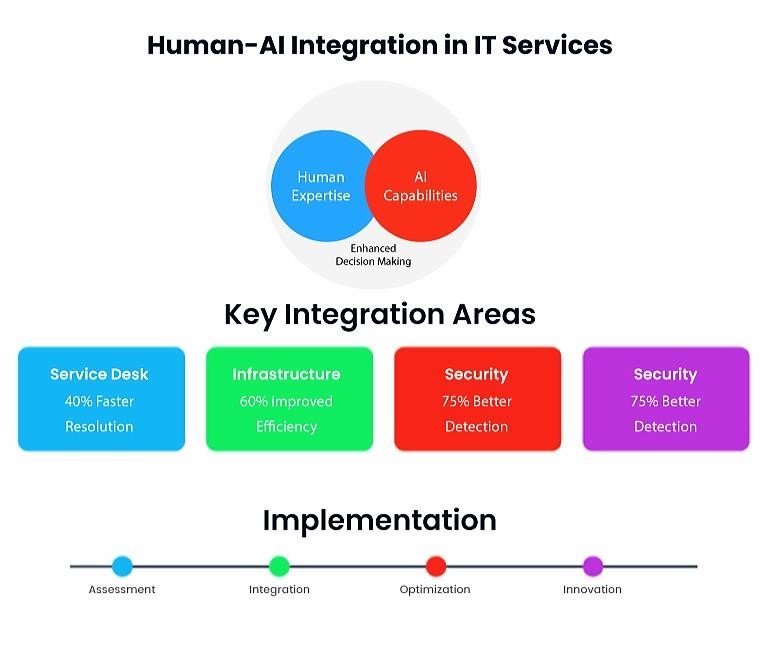The Evolution of IT Services
The IT service landscape has undergone a dramatic transformation with the integration of AI technologies. Human expertise remains irreplaceable, but AI now augments and enhances these capabilities in unprecedented ways. This synergy between human insight and artificial intelligence creates a new paradigm in IT service delivery that maximizes efficiency while maintaining the critical human element.
Understanding the Human-AI Partnership
The Role of Human Expertise
IT professionals bring critical thinking, emotional intelligence, and complex problem-solving abilities that AI cannot replicate. They excel at understanding context, making nuanced decisions, and building relationships with clients and stakeholders.
AI’s Contribution
⦁ Automated routine tasks
⦁ Pattern recognition
⦁ Data analysis
⦁ Predictive maintenance
⦁ Real-time monitoring
The Synergy Effect
When human expertise combines with AI capabilities, organizations experience:
⦁ 40% increase in productivity
⦁ 60% faster problem resolution
⦁ 75% improvement in accuracy
⦁ 30% reduction in costs
Key Areas of Integration
Service Desk Operations
Human agents focus on complex issues while AI handles routine queries. This partnership ensures faster resolution times and improved user satisfaction.
Infrastructure Management
AI monitors and maintains systems while humans make strategic decisions about architecture and optimization. Together they create more reliable and efficient infrastructure solutions.
Lorem ipsum dolor sit amet, consectetur adipiscing elit. Ut elit tellus, luctus nec ullamcorper mattis, pulvinar dapibus leo.Security Operations
⦁ AI provides real-time threat detection
⦁ Humans analyze complex threats
⦁ Combined incident response
⦁ Proactive security planning
⦁ Enhanced risk management
Implementation Strategy
Assessment Phase
Organizations must evaluate their current capabilities and identify integration points. This process requires careful analysis of both human resources and technological infrastructure.
Training and Development
⦁ Technical skill enhancement
⦁ AI literacy programs
⦁ Change management
⦁ Collaboration frameworks
⦁ Performance metrics
Integration Timeline
⦁ Phase 1: Basic automation
⦁ Phase 2: Advanced AI integration
⦁ Phase 3: Full synergy implementation
⦁ Phase 4: Continuous optimization
Measuring Success
Quantitative Metrics
⦁ Response time improvement
⦁ Cost reduction
⦁ Error rate decrease
⦁ Customer satisfaction scores
⦁ Resource utilization
Qualitative Assessment
⦁ Employee satisfaction
⦁ Work-life balance
⦁ Job satisfaction
⦁ Career development
⦁ Innovation potential
Future Trends and Innovations
Implementation Strategy
The next wave of innovation will bring:
⦁ Advanced natural language processing
⦁ Enhanced predictive analytics
⦁ Improved machine learning models
⦁ Extended reality integration
⦁ Quantum computing applications
Workforce Evolution
⦁ New job roles emergence
⦁ Skill requirement changes
⦁ Career path evolution
⦁ Training methodology updates
⦁ Collaboration frameworks
Best Practices for Success
Communication Strategy
Clear communication channels between human teams and AI systems are essential. Regular feedback loops ensure continuous improvement and optimization.
Change Management
⦁ Employee engagement programs
⦁ Regular training sessions
⦁ Performance monitoring
⦁ Feedback incorporation
⦁ Continuous improvement
Challenges and Solutions
Technical Integration
⦁ System compatibility issues
⦁ Data quality management
⦁ Integration complexity
⦁ Performance monitoring
⦁ Security concerns
Cultural Adaptation
Organizations must foster a culture that embraces both human expertise and AI capabilities. This requires careful change management and continuous support.
Conclusion
The future of IT services lies in the successful integration of human expertise and AI capabilities. Organizations that effectively balance these elements will achieve superior results in service delivery, cost efficiency, and innovation.


